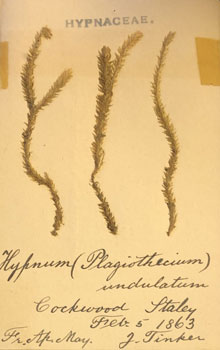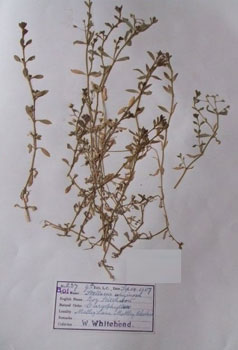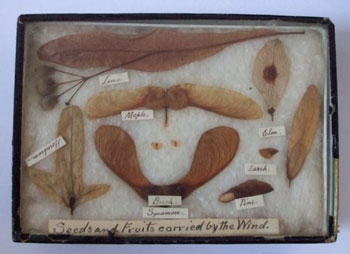Botany collections - Pressed Plants and Mosses
Tameside Museums are very lucky to have a beautiful collection of pressed plants and mosses. These are rarely seen as they are very fragile, sensitive to light and difficult to display.
 The mosses were collected by the wonderfully named Jethro Tinker (1788-1871) during the early nineteenth century. There are over 100 specimens and they are beautifully pressed on postcard sized piece of white paper with handwritten notes by Tinker. Many were collected in Tameside, others in Derbyshire.
The mosses were collected by the wonderfully named Jethro Tinker (1788-1871) during the early nineteenth century. There are over 100 specimens and they are beautifully pressed on postcard sized piece of white paper with handwritten notes by Tinker. Many were collected in Tameside, others in Derbyshire.He was born in a cottage in the Brushes Valley high above Stalybridge and grew up surrounded by the countryside which inspired his love of nature. He worked in the local cotton industry and eventually became a manager at Cheetham Mills. The long hours he worked did not detract from his enthusiasm for natural history and he collected specimens of wildflowers, mosses, insects, moths, butterflies and shells. He became well-known by other botanists especially through his work with local societies that had grown up in many towns to promote the study of natural history.
One of his fellow botanists described him as: "A good botanist and entomologist and an enthusiastic admirer of nature, whose open countenance and straightforward conduct plainly showed the kind heart within him."
He left mill work in later life, working as a shopkeeper and publican. His final job, which must have been a dream job for him, was a gardener at Eastwood Park in Stalybridge. When he died in 1871, at the age of 83, a monument was built to him in Stamford Park and a blue plaque dedicated to him is situated at the entrance to Stalybridge Country Park.
Moss collected by Jethro Tinker
 In 1951, 2,680 pressed plants collected by local botanists W. Whitehead and J.E. Sunderland were added to the collections. Both were members of the Botanical Exchange Club and their collections were held at Stalybridge Library and Stamford Park Museum, which was located in Stamford Park and demolished in 1955. Some were collected locally, others throughout the country and some in North Wales. These are beautifully mounted on paper and annotated with handwritten notes.
In 1951, 2,680 pressed plants collected by local botanists W. Whitehead and J.E. Sunderland were added to the collections. Both were members of the Botanical Exchange Club and their collections were held at Stalybridge Library and Stamford Park Museum, which was located in Stamford Park and demolished in 1955. Some were collected locally, others throughout the country and some in North Wales. These are beautifully mounted on paper and annotated with handwritten notes. A small collection of seeds, leaves and fruits were collected Robert Jackson in the early 1900s. The example here shows eight varieties of ‘seeds and fruits carried by the wind’ including pine, sycamore, hornbeam, birch, larch, elm, maple and lime. The collection, along with hundreds of fossils and rocks also collected by Robert Jackson, were donated to Stalybridge Library by his daughters in 1933.
A small collection of seeds, leaves and fruits were collected Robert Jackson in the early 1900s. The example here shows eight varieties of ‘seeds and fruits carried by the wind’ including pine, sycamore, hornbeam, birch, larch, elm, maple and lime. The collection, along with hundreds of fossils and rocks also collected by Robert Jackson, were donated to Stalybridge Library by his daughters in 1933.
